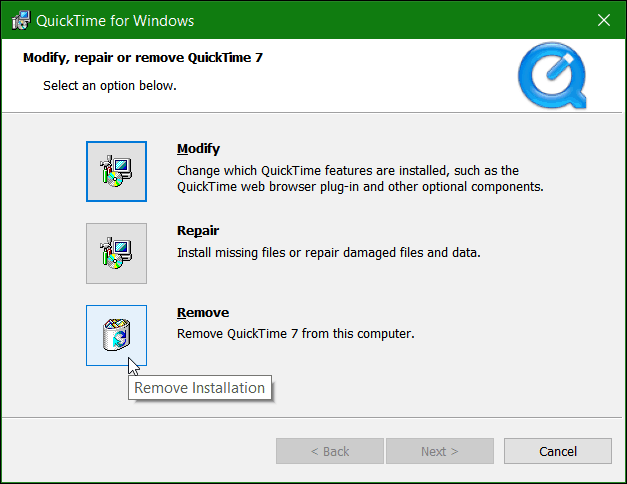Apple QuickTime for Windows Security Risk, Homeland Security says Uninstall Now (Update)

As if the recent Adobe Flash Player security exploits wasn’t enough to worry about, there’s a new threat for Windows users – this time from Apple.
As if the Adobe Flash Player security exploits weren’t enough to worry about, there’s a new threat for Windows users – this time from Apple. Security firm Trend Micro this week announced the discovery of two new critical vulnerabilities in QuickTime for Windows.
The Computer Emergency Readiness Team, which is part of the Department of Homeland Security, issued security alert (TA16-105A) on Thursday calling for all Windows users to uninstall the program.
Trend Micro says it hasn’t discovered any active attacks that target the newly found vulnerabilities (at least not yet). According to Trend Micro’s security bulletin:
We’re not aware of any active attacks against these vulnerabilities currently. But the only way to protect your Windows systems from potential attacks against these or other vulnerabilities in Apple QuickTime now is to uninstall it. In this regard, QuickTime for Windows now joins Microsoft Windows XP and Oracle Java 6 as software that is no longer being updated to fix vulnerabilities and subject to ever increasing risk as more and more unpatched vulnerabilities are found affecting it.
However, since Apple has abandoned QuickTime for Windows and will no longer support it, the only way to protect yourself from an attack is to get rid of it. This security issue only affects Windows and not OS X systems.
If you have iTunes installed on your Windows PC, chances are you also have QuickTime as it came bundled in the iTunes installer before version 10.5.
Uninstall QuickTime on Windows
To uninstall it from Windows 10, go to Settings > System > Apps & features. Scroll down to QuickTime, click it and then uninstall.


To uninstall it from Windows 7, open Control Panel and then select Programs and Features. Find QuickTime, right-click it, and hit Uninstall. Then follow the uninstall wizard on the screen.


Keep in mind that Apple installs a bunch of software with iTunes, and using this method only gets rid of QuickTime, which is what you want.
It’s worth noting, though, that if you want to get rid of all traces of QuickTime that its built-in uninstaller typically misses, use a program like Revo Uninstaller to remove it.
For more details on uninstalling software thoroughly, read our article: How Do I Completely Uninstall Software on Windows?
Update 4/18/2016: Apple has been quiet about this situation, and today finally officially announced that it is no longer supporting QuickTime to the WallStreet Journal:
Apple confirmed to The Wall Street Journal that it is no longer supporting or updating the 11-year-old QuickTime 7 for Windows, and has posted instructions for uninstalling the software. Keeping it installed on your computer may pose a risk.
You can find the article here.
Apple QuickTime is long in the tooth and isn’t much anymore like it used to be. Even Apple’s own movie trailer site no longer requires it. Personally, I can’t even remember the last time I used it.
What’s your take? Do you use QuickTime on Windows or have you ever used it? Leave a comment below and let us know your thoughts on the subject.
13 Comments
Leave a Reply
Leave a Reply







Tiny du Preez
April 15, 2016 at 7:27 am
I work in the television and film business and my software requires QuickTime to play video content. . . . What to do?
john R
April 15, 2016 at 2:08 pm
Me too Avid requires Quicktime
john Randall
April 15, 2016 at 2:23 pm
Why is Apple not fixing this? I have removed all my Mac computers from my workstations because of Apples “Non Help” to the FBI with the “iPhone crack”. Now another reason to find a problem fixer for an Apple product. All the Video software used in the film industry uses Quicktime and guess what more than half use Windows! So now?
john R
Brian Burgess
April 15, 2016 at 4:51 pm
I am not a video editor, so I am not too familiar with QuickTime and its use cases.
Are there any alternatives you can use in conjunction with your video editing programs or any type of work arounds?
As far as just viewing videos, there are plenty of other options for Windows, our favorite being VLC.
Also, remember that this only affects Windows and not OS X.
As noted in the article, there haven’t been any known exploits yet, and QuickTime will continue to work.
However, since Apple is no longer supporting it for Windows, it leaves your PC vulnerable going forward.
We’ll continue to follow and report on the story as it develops.
Brian Burgess
April 15, 2016 at 5:01 pm
To be affected by the exploits that were found, you’d need to download and watch a malicious video.
Apple hasn’t supported QuickTime for Windows 8 or 10 anyway.
Still, it would have been nice for Apple to make a statement or send current users an email explaining the issue at least.
By not updating it since January and apparently no longer supporting it for Windows, it could be a devious ploy by Apple to make people in the video industry to buy a Mac…?
Gergely K
April 16, 2016 at 12:03 am
Could you please reaffirm that QT player poses a risk for Windows 10 users _only_ if they download and watch a malicious video? I am not sure I got that bit right…
I would like to be sure whether or not I am safe if all I ever use QT for is videos shot and edited by myself.
Thank you very much in advance! Have a nice day!
Stefan
April 15, 2016 at 8:15 pm
Hey guys – to any fellow video editors out there – I know how you feel. I’m working on a project right now which I initially planned to export in H.264, but alas – I’ll have to completely change those plans.
For any Media Composer or Premiere users I’d recommend exporting your video materials to an alternative codec like DNxHD and then using a free third-party converter like FreeStudio to convert your files to H.264, ProRes or whatever else you may need.
As for playback of MOV on Windows your best bet would be Media Player Classic Home Cinema or VLC – both feature built-in codecs which should play back your videos without a single hiccup.
Also – I know – these solutions aren’t necessarily the best ones but if you’re panicking and you just want a quick fix they should do for the time being.
Brian Burgess
April 17, 2016 at 12:17 am
Thank you Stefan. Very helpful!
Curtis Ling
April 19, 2016 at 2:32 am
just keep using quicktime
h264 rocks
its not like you have LESS venerable programs on your pc
esp when WMP is as old as windows 7
Tiny du Preez
April 15, 2016 at 10:12 pm
Good news then for now… I am a big Mac fan (Not the burger), but with the exchange rate being what it is in South Africa, even buying a top spec pc is a bit if a stretch..
Besides, it seens senseless to pay three times the price for a machine that essentially does the sane job…
I am a sound designer, and find that Pro Tools runs perfectly good on an i7.
Tiny du Preez
April 15, 2016 at 10:14 pm
Pardon the typo’s. I wrote this on my phone…
Tiny du Preez
April 15, 2016 at 10:15 pm
GOM Player also works fine…
Mark P
March 14, 2022 at 6:32 am
You should warn people. Uninstalling QuickTime is going to cause a lot of their old video games and software to stop functioning.
I unplugged my Windows 10 computer from the internet so it would stop updating. I use an older computer for the internet. Problems solved.